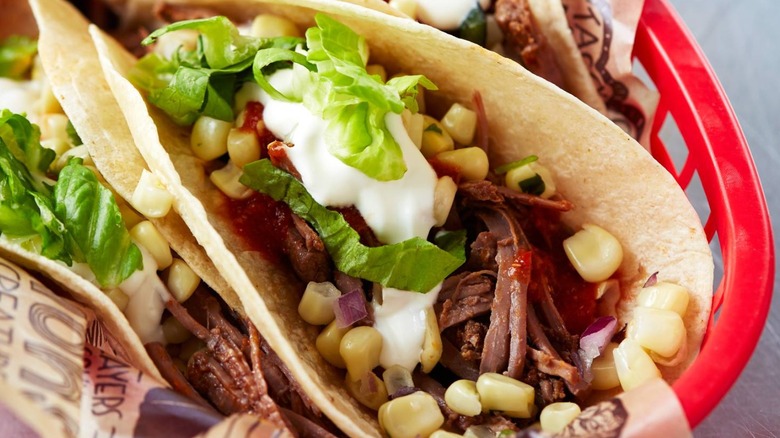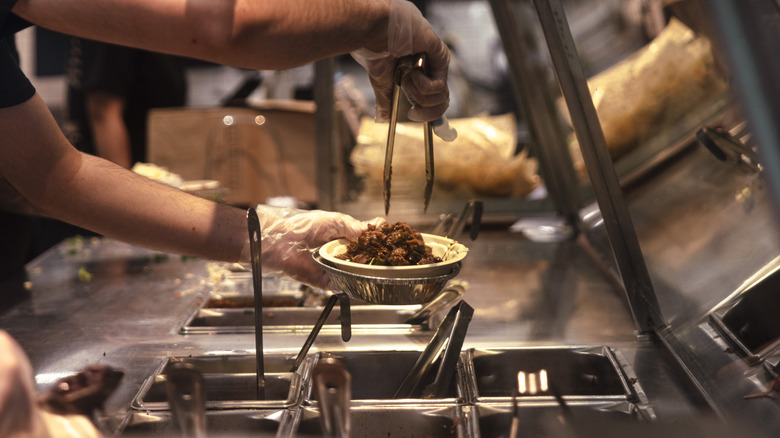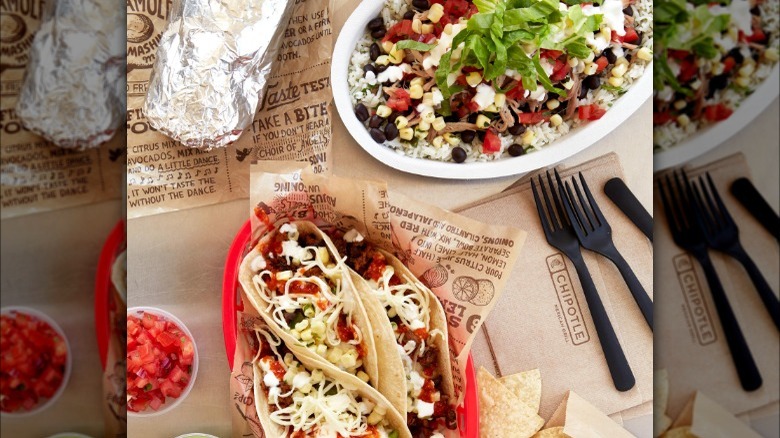The Key Flavor Difference Between Chipotle's Barbacoa And Carnitas
With 53 ingredients comprising the entirety of Chipotle's menu, there are an infinite number of combinations to choose from to craft a delicious meal. You can get burritos, tacos, bowls, or salads made with chicken, steak, plant-based sofritas, veggies with guacamole, and even carne asada during limited times. But, there are two other meat choices that may appear similar, but are quite different — carnitas and barbacoa.
Their key flavor differences come from the type of meat they're made with, and the spices and seasonings Chipotle uses to jazz them up. Both types offer slowly braised and shredded meat, but carnitas are made from pork and a bit sweeter while barbacoa is made from beef and is spicier. One of the main flavor differences in Chipotle's carnitas recipe is a rather unexpected ingredient — juniper berries. Known for being the main ingredient in gin, these berries are pungent, piney, and citrusy, and they go perfectly with pork. Carnitas are customarily made with orange juice, but here juniper provides that acidic component and complexity just as well.
Chipotle's barbacoa on the other hand is made with more familiar herbs and spices used in Mexican food, but it too offers some surprises. It's spicier than the carnitas thanks to the inclusion of chili peppers, but also another spice, which brings the whole dish together: cloves. Both sweet and slightly bitter, aromatic cloves provide a bit of heat along the lines of cinnamon and are the perfect foil to the otherwise savory spices that flavor the tender beef.
All the flavors that go into making Chipotle's carnitas
Along with the dried and crushed juniper berries featured in Chipotle's carnitas, the other primary flavor note comes from thyme. The aromatic herb is widely used in Mexican cooking and, in this scenario, gives the pork notes of lemon and mint. In fact, thyme is considered one of Mexican cuisine's main hierbas de olor (aromatic or fragrant herbs), which are used to flavor soups, stews, and meats. Thyme's flavor lifts up the more subtle flavors in the recipe, such as bay leaves, which are also used. Surprisingly, the only other ingredients in the dish are black pepper and kosher salt, along with the oil that it gets cooked in.
Carnitas – "little meats" in Spanish –have historically been cooked with pork fat lard. The lard not only maximizes the pork-on-pork flavor but is also used for either frying or roasting the meat to give it a crispy finish. In lieu of lard, Chipotle cooks its carnitas with sunflower oil, which the company only uses in a few other items that pair best with a milder oil. Another thing that's mild is the heat level, as there are no chilis used in the preparation of carnitas, making the filling an excellent choice for those who like their meat flavorful but not too spicy.
How Chipotle gets its barbacoa so tender
Chipotle's other shredded meat option is beef barbacoa. The Mexican recipe's name literally means barbecue, and the way it's cooked is believed to have come from the Caribbean. Barbacoa is traditionally wrapped or covered in leaves, such as agave or banana, and cooked slowly and directly over flames or in dug-out pits. Modern, more accessible methods have evolved to allow for the use of roasting in a Dutch oven or slow cooking in a crock pot.
To achieve barbacoa's signature tender texture, Chipotle cooks its beef sous vide at length before marinating it for a half-day in a flavorful adobo blend and braising it. The meat is then shredded by hand. The process yields exceptionally moist and juicy meat despite the lengthy cooking process. Unlike the sunflower oil used in the carnitas, the barbacoa (along with the rest of Chipotle's meats, rice, and salad dressing), is cooked in rice bran oil. It too has a mild flavor that doesn't overpower the food it's cooked with, but is chosen for its ability to withstand the high heat of grilling.
Chipotle's barbacoa shares bay leaves, salt, and pepper in common with the carnitas. The more heavily spiced barbacoa also features classic Mexican flavors like oregano, cumin, and garlic, and gets a fiery hit from chilis and cloves. Specifically, the brand's namesake chipotle peppers which are smoked for days using pecan wood. Interestingly, the company has been sourcing its chili peppers from the farm of Javier Fierro in Chihuahua, Mexico for over 15 years for even more authentic flavor.



